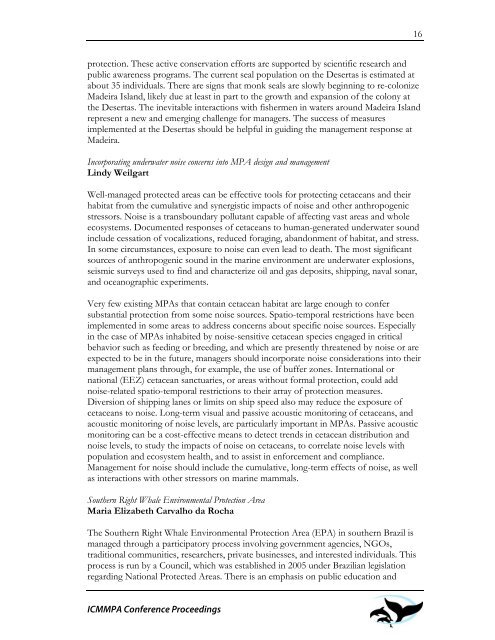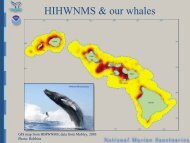The First International Conference on Marine Mammal Protected Areas
The First International Conference on Marine Mammal Protected Areas
The First International Conference on Marine Mammal Protected Areas
Create successful ePaper yourself
Turn your PDF publications into a flip-book with our unique Google optimized e-Paper software.
protecti<strong>on</strong>. <str<strong>on</strong>g>The</str<strong>on</strong>g>se active c<strong>on</strong>servati<strong>on</strong> efforts are supported by scientific research and<br />
public awareness programs. <str<strong>on</strong>g>The</str<strong>on</strong>g> current seal populati<strong>on</strong> <strong>on</strong> the Desertas is estimated at<br />
about 35 individuals. <str<strong>on</strong>g>The</str<strong>on</strong>g>re are signs that m<strong>on</strong>k seals are slowly beginning to re-col<strong>on</strong>ize<br />
Madeira Island, likely due at least in part to the growth and expansi<strong>on</strong> of the col<strong>on</strong>y at<br />
the Desertas. <str<strong>on</strong>g>The</str<strong>on</strong>g> inevitable interacti<strong>on</strong>s with fishermen in waters around Madeira Island<br />
represent a new and emerging challenge for managers. <str<strong>on</strong>g>The</str<strong>on</strong>g> success of measures<br />
implemented at the Desertas should be helpful in guiding the management resp<strong>on</strong>se at<br />
Madeira.<br />
Incorporating underwater noise c<strong>on</strong>cerns into MPA design and management<br />
Lindy Weilgart<br />
Well-managed protected areas can be effective tools for protecting cetaceans and their<br />
habitat from the cumulative and synergistic impacts of noise and other anthropogenic<br />
stressors. Noise is a transboundary pollutant capable of affecting vast areas and whole<br />
ecosystems. Documented resp<strong>on</strong>ses of cetaceans to human-generated underwater sound<br />
include cessati<strong>on</strong> of vocalizati<strong>on</strong>s, reduced foraging, aband<strong>on</strong>ment of habitat, and stress.<br />
In some circumstances, exposure to noise can even lead to death. <str<strong>on</strong>g>The</str<strong>on</strong>g> most significant<br />
sources of anthropogenic sound in the marine envir<strong>on</strong>ment are underwater explosi<strong>on</strong>s,<br />
seismic surveys used to find and characterize oil and gas deposits, shipping, naval s<strong>on</strong>ar,<br />
and oceanographic experiments.<br />
Very few existing MPAs that c<strong>on</strong>tain cetacean habitat are large enough to c<strong>on</strong>fer<br />
substantial protecti<strong>on</strong> from some noise sources. Spatio-temporal restricti<strong>on</strong>s have been<br />
implemented in some areas to address c<strong>on</strong>cerns about specific noise sources. Especially<br />
in the case of MPAs inhabited by noise-sensitive cetacean species engaged in critical<br />
behavior such as feeding or breeding, and which are presently threatened by noise or are<br />
expected to be in the future, managers should incorporate noise c<strong>on</strong>siderati<strong>on</strong>s into their<br />
management plans through, for example, the use of buffer z<strong>on</strong>es. <str<strong>on</strong>g>Internati<strong>on</strong>al</str<strong>on</strong>g> or<br />
nati<strong>on</strong>al (EEZ) cetacean sanctuaries, or areas without formal protecti<strong>on</strong>, could add<br />
noise-related spatio-temporal restricti<strong>on</strong>s to their array of protecti<strong>on</strong> measures.<br />
Diversi<strong>on</strong> of shipping lanes or limits <strong>on</strong> ship speed also may reduce the exposure of<br />
cetaceans to noise. L<strong>on</strong>g-term visual and passive acoustic m<strong>on</strong>itoring of cetaceans, and<br />
acoustic m<strong>on</strong>itoring of noise levels, are particularly important in MPAs. Passive acoustic<br />
m<strong>on</strong>itoring can be a cost-effective means to detect trends in cetacean distributi<strong>on</strong> and<br />
noise levels, to study the impacts of noise <strong>on</strong> cetaceans, to correlate noise levels with<br />
populati<strong>on</strong> and ecosystem health, and to assist in enforcement and compliance.<br />
Management for noise should include the cumulative, l<strong>on</strong>g-term effects of noise, as well<br />
as interacti<strong>on</strong>s with other stressors <strong>on</strong> marine mammals.<br />
Southern Right Whale Envir<strong>on</strong>mental Protecti<strong>on</strong> Area<br />
Maria Elizabeth Carvalho da Rocha<br />
<str<strong>on</strong>g>The</str<strong>on</strong>g> Southern Right Whale Envir<strong>on</strong>mental Protecti<strong>on</strong> Area (EPA) in southern Brazil is<br />
managed through a participatory process involving government agencies, NGOs,<br />
traditi<strong>on</strong>al communities, researchers, private businesses, and interested individuals. This<br />
process is run by a Council, which was established in 2005 under Brazilian legislati<strong>on</strong><br />
regarding Nati<strong>on</strong>al <strong>Protected</strong> <strong>Areas</strong>. <str<strong>on</strong>g>The</str<strong>on</strong>g>re is an emphasis <strong>on</strong> public educati<strong>on</strong> and<br />
ICMMPA <str<strong>on</strong>g>C<strong>on</strong>ference</str<strong>on</strong>g> Proceedings<br />
16



